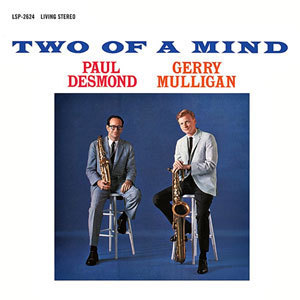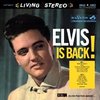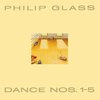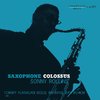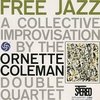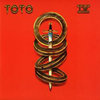AAA 100% Analogue This LP was Remastered using Pure Analogue Components Only from the Master Tapes through to the Cutting Head
Speakers Corner / RCA - LSP-2624 - 180 Gram Virgin Vinyl
Limited Edition - Pure Analogue Audiophile Mastering - Pressed at Pallas Germany
Speakers Corner 30 Years Pure Analogue This LP is an Entirely Analogue Production
"Altoist Paul Desmond and baritonist Gerry Mulligan always made for a perfect team during their infrequent collaborations. Both of the saxophonists had immediately distinctive light tones, strong wits, and the ability to improvise melodically...The interplay between Desmond and Mulligan is consistently delightful. Highly recommended." Great sonics. Highly recommended. 5/5 Vinylde
Although the beautiful sound, mutual understanding and harmonic balance mostly predominate, the music of alto saxophonist Paul Desmond performing together with baritone saxophonist Gerry Mulligan is far from what one calls 'easy listening'. For many, it is even difficult to identify the melody of evergreens such as "Stardust" and "The Way You Look Tonight". (And what theme is tucked away in "Two Of A Mind"????)
The recording in the RCA Victor Studio took place over several days in 1962, and this is why different bass players and percussionists are heard – Wendell Marshall, Joe Benjamin and John Beal each take their turn on the bass, while Connie Kay and Mel Lewis change places behind the drum set. These musicians form a brilliant team, and that there is no piano is both deliberate and inevitable for Gerry Mulligan recordings of the day. By the way, the second saxophonist in "The Way You Look Tonight" is Paul Desmond – by means of over-dubbing in the middle of the stereo recording!
The present LP could certainly take a rightful place in a 'Best Of' collection alongside the other recordings by Gerry Mulligan with Ben Webster and Stan Getz.
Paul Desmond is revered for the pure, gentle tone of his alto saxophone, and the elegant lyricism of his improvisations. For seventeen years he was the lead soloist in the most commercially successful jazz combo ever, the Dave Brubeck Quartet. In an era that worshipped the frenetic, bebop style of Charlie Parker, Paul Desmond found his own sound, a tone that he claimed imitated a "dry martini." It was a sound that made him a favourite with critics and fans alike, and won him jazz poll after jazz poll. "I have won several prizes as the world's slowest alto player, as well as a special award in 1961 for quietness." He was a modest, retiring man, known to his friends for his wit and charm. Twenty years after his passing, his music still sells, is still played, and still moves people.
One of the most widely respected and admired jazz musicians of our time, Gerry Mulligan occupies a unique place in the American musical scene. Recognized as an important 20th century composer, arranger, saxophonist, and conductor, he has played a vital role in the history of modern jazz and contemporary music. Mulligan has performed with such jazz immortals as Louis Armstrong, Count Basie, Lester Young, Duke Ellington, Miles Davis, Jack Teagarden, Dave Brubeck, Billie Holliday, and of course, Paul Desmond. He was consistently voted number one in jazz polls around the world and has won a record twenty-nine consecutive Down Beat Readers Poll awards.
"Altoist Paul Desmond and baritonist Gerry Mulligan always made for a perfect team during their infrequent collaborations. Both of the saxophonists had immediately distinctive light tones, strong wits, and the ability to improvise melodically... The songs all utilize common chord changes, including the two 'originals' ('Two of a Kind' and 'Blight of the Fumble Bee'), and the interplay between Desmond and Mulligan is consistently delightful. Highly recommended." - Scott Yanow, allmusic.com
"Two of the finest talents to emerge in the post-war jazz generation are brought together here for a happy, informal, yet earnest session of music-making. Individualy, Paul Desmond and Gerry Mulligan can each look back at a decade of winning jazz polls -- Paul as the alto saxophonist of the Dave Brubeck Quartet, and Gerry as a baritone saxophonist who has led his own groups for many years, ranging from a quartet to a full-sized band... [A] series of sweeping performances in which something exciting is happening every instant, whether it be a solo of keen inventiveness or a duet passage in which each line stands up by itself within a whole that sounds like the work of a craftsman composer." - George Avakian, Original Album Notes
Recording: 1962 at RCA Victor's Studio A, New York City by Ray Hall, Bob Simpson and Mickey Crofford
Production: Bob Prince and George Avakian
Musicians:
Paul Desmond, alto sax
Gerry Mulligan, baritone sax
Wendell Marshall, bass
Joe Benjamin, bass
John Beal, bass
Connie Kay, guest artist, drums
Mel Lewis, drums
Selections:
1. All The Tings You Are
2. Stardust
3. Two Of A Mind
4. Blight Of the Fumble Bee
5. The Way You Look Tonight
6. Out Of Nowhere
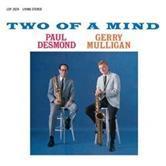
Are your records completely analogue?
Yes! This we guarantee!
As a matter of principle, only analogue masters are used, and the necessary cutting delay is also analogue. All our cutting engineers use only Neumann cutting consoles, and these too are analogue. The only exception is where a recording has been made – either partly or entirely – using digital technology, but we do not have such items in our catalogue at the present time
Are your records cut from the original masters?
In our re-releases it is our aim to faithfully reproduce the original intentions of the musicians and recording engineers which, however, could not be realised at the time due to technical limitations. Faithfulness to the original is our top priority, not the interpretation of the original: there is no such thing as a “Speakers Corner Sound”. Naturally, the best results are obtained when the original master is used. Therefore we always try to locate these and use them for cutting. Should this not be possible, – because the original tape is defective or has disappeared, for example – we do accept a first-generation copy. But this remains an absolute exception for us.
Who cuts the records?
In order to obtain the most faithful reproduction of the original, we have the lacquers cut on the spot, by engineers who, on the whole, have been dealing with such tapes for many years. Some are even cut by the very same engineer who cut the original lacquers of the first release. Over the years the following engineers have been and still are working for us: Tony Hawkins, Willem Makkee, Kevin Gray, Maarten de Boer, Scott Hull, and Ray Staff, to name but a few.
At the beginning of the ‘90s, in the early days of audiophile vinyl re-releases, the reissue policy was fairly straightforward. Companies such as DCC Compact Classics, Mobile Fidelity, Classic Records and others, including of course Speakers Corner, all maintained a mutual, unwritten code of ethics: we would manufacture records sourced only from analogue tapes.
Vinyl’s newfound popularity has led many other companies to jump on the bandwagon in the hope of securing a corner of the market. Very often they are not so ethical and use every imaginable source from which to master: CDs, LPs, digital files and even MP3s.
Even some who do use an analogue tape source employ a digital delay line, a misguided ’80s and ‘90s digital technology that replaces the analogue preview head originally used to “tell” the cutter head in advance what was about to happen musically, so it could adjust the groove “pitch” (the distance between the grooves) to make room for wide dynamic swings and large low frequency excursions. Over time analogue preview heads became more rare and thus expensive.
So while the low bit rate (less resolution than a 16 bit CD) digital delay line is less expensive and easier to use than an analogue “preview head”, its use, ironically, results in lacquers cut from the low bit rate digital signal instead of from the analogue source!
Speakers Corner wishes to make clear that it produces lacquers using only original master tapes and an entirely analogue cutting system. New metal stampers used to press records are produced from that lacquer. The only exceptions are when existing metal parts are superior to new ones that might be cut, which includes our release of “Elvis is Back”, which was cut by Stan Ricker or several titles from our Philips Classics series, where were cut in the 1990s using original master tapes by Willem Makkee at the Emil Berliner Studios. In those cases we used only the original “mother” to produce new stampers.
In addition, we admit to having one digital recording in our catalogue: Alan Parsons’ “Eye in the Sky”, which was recorded digitally but mixed to analogue tape that we used to cut lacquers.
In closing, we want to insure our loyal customers that, with but a few exceptions as noted, our releases are “AAA”— analogue tape, an all analogue cutting system, and newly cut lacquers.
